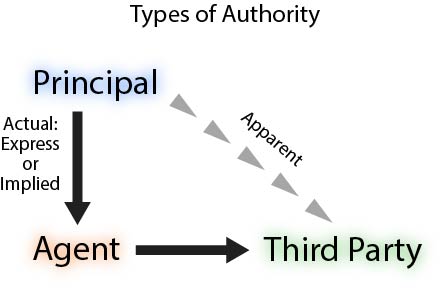Information
Table of Contents menu search Search build_circle Toolbar fact_check Homework cancel Exit Reader Mode school Campus Bookshelves menu_book Bookshelves perm_media Learning Objects login Login how_to_reg Request Instructor Account hub Instructor Commons Bright Blues Gray Inverted Downloads expand_more Download Page (PDF) Download Full Book (PDF) Resources expand_more Periodic Table Physics Constants Reference expand_more Reference & Cite Tools expand_more Help expand_more Get Help Feedback Readability x chrome_reader_mode Enter Reader Mode Sep 14, 2021 15.1: Introduction 15.3: Duties of Agents and Principals 15.1: Introduction 15.3: Duties of Agents and Principals 15.1: Introduction 15.3: Duties of Agents and Principals 15.4: Liability to Third Parties 15.5: Termination of Agency Relationship ® contents contents readability readability resources resources tools tools ☰ x selected template will load here This action is not available. ( \newcommand{\kernel}{\mathrm{null}\,}\) An agency relationship is created when one person or entity agrees to perform a task for, and under the direction of, another individual or entity. An agent is the person who is authorized to act for or in place of another. A principal is the person who authorizes another to act on his, her, or its behalf as an agent. Agency is a fiduciary relationship created by express contract or implied actions, in which the agent has the authority to act on behalf of the principal and legally bind the principal to third parties. A fiduciary relationship is a relationship in which one person is under a duty to act for the benefit of the other on matters within the scope of the relationship. Fiduciary relationships require trust, good faith, and acting in the best interest of the other. In fiduciary relationships, the law requires the fiduciary to act with the highest duty of care. This means that the fiduciary must put the interests of the other party before their own. Examples of fiduciary relationships include doctor-patient, attorney-client, accountant-client, trustee-beneficiary, and guardian-child. An agent is also a fiduciary of a principal. There are three types of principals, which are described from the perspective of a third party: disclosed, partially disclosed, and undisclosed. A disclosed principal is a principal whose identity is revealed by the agent to a third party. These are the most common types of principals. For example, employees work for a disclosed principal when they are on the employer’s premise, wear a name badge or uniform identifying the employer, or answer the phone by identifying the employer’s name. A partially disclosed principal is a principal whose existence, but not actual identity, is revealed by the agent to a third party. In other words, a third party knows that the agent represents a principal but does not know the identity of the principal. For example, a realtor in Aspen may represent celebrities and wealthy individuals who want to purchase property but do not want the paparazzi to publicize the information. An undisclosed principal is a principal whose identity is kept secret by the agent. Often third parties do not realize that an agency relationship exists and believe that the agent is working on his or her own behalf. Undisclosed principals occur when the identity of the principal can lead to increased purchase prices, unwanted publicity, and security concerns. An agent is someone who is authorized to act on behalf of a principal. Because there is a variety of authority that a principal can grant an agent, there are many different types of agents. In general, agents are described as either general or special. General agents have the authority to transact all the principal’s business of a particular kind or in a particular place. General agents often include partners, managers, factors and brokers. Special agents, in contrast, only have the authority to conduct a particular transaction or to perform a specific act. Special agents often include realtors, athlete’s agents, and employment recruiters. Some of the most common business agents include: Authority is the right or permission to act legally on another’s behalf. In general, authority can be either actual or apparent. Actual authority, sometimes called real authority, occurs when a principal intentionally confers authority on an agent. Actual authority can be either express or implied. Express authority is authority given by an express agreement, either orally or in writing. Implied authority is authority granted to the agent as a result of the principal’s conduct. Figure 15.1 Types of Authority Apparent authority is authority that a third party reasonably believes an agent has, based on the third party’s dealings with the principal. If a principal’s words or actions lead others to believe that he or she gave authority to someone else, then the principal is held accountable even if no authority was actually given to the agent. For example, if a principal fails to give notice that an agent is no longer working for the principal, the agent may still bind the principal through apparent authority when dealing with third parties. To constitute apparent authority, three elements must be met: Sometimes an agent acts without authority. If a disclosed principal likes what an agent does, even if done without authority at the time, the principal can still benefit from the agent’s actions. Ratification occurs when a disclosed principal adopts or confirms a contract entered into on his or her behalf by an agent who did not have authority to act. Unlike apparent authority, the third party does not have to be injured. Rather, ratification allows principals to enter into contracts for their benefit. Ratification is an “all or nothing” doctrine that prevents principals from ratifying only part of the contract or renegotiating its terms. This page titled 15.2: The Agency Relationship is shared under a CC BY 4.0 license and was authored, remixed, and/or curated by Melissa Randall and Community College of Denver Students via source content that was edited to the style and standards of the LibreTexts platform. The LibreTexts libraries are Powered by NICE CXone Expert and are supported by the Department of Education Open Textbook Pilot Project, the UC Davis Office of the Provost, the UC Davis Library, the California State University Affordable Learning Solutions Program, and Merlot. We also acknowledge previous National Science Foundation support under grant numbers 1246120, 1525057, and 1413739. Legal. Accessibility Statement For more information contact us at info@libretexts.org.




